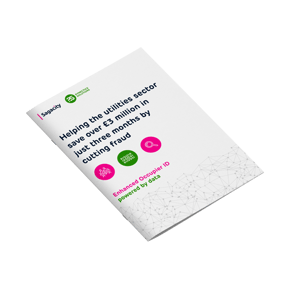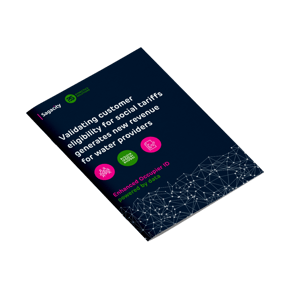

Sagacity and Synectics Solutions are partnered to help utility providers to better know their customers. By leveraging data, providers can address tariff fraud, identify unknown occupiers and support vulnerable customers. See how we've helped other providers with two real stories:

Helping the Utilities sector save over £3 million in just three months by cutting fraud
Read the case study
Validating customer eligibility for social tariffs generates new revenue for water providers
Read the case studySuppliers Driven by Regulation
While statistics show that circa 735,095 properties are officially empty in Great Britain, Sagacity and Synectics Solutions have observed through work together in the water industry that providers register a higher number of void sites than those being reported in the government statistics. This would suggest many properties are not being billed, despite being occupied.
In some cases, this difference can be attributed to the way in which water companies define and report on empty (void) properties. For example, a water company may report a newly occupied property as empty where the customer has not yet got in contact with their supplier, so the property has no named occupier to bill.
However, in line with Ofwat commitments, providers have specific voids targets to attain. This varies for each supplier as their mandate is calculated using the number of properties they supply, but the financial penalties for failing to comply are universal. Heavy regulation on a constantly changing industry of customers makes it difficult for suppliers to measure their void properties accurately, let alone fix the gap between what’s reported and their Ofwat target.
An Ever-Moving Challenge
Within void properties lie:
- customers who can pay but aren’t billed correctly
- customers who don’t want to pay so avoid unnamed correspondence
- those who want to pay but can’t as they require financial support
It is the providers’ responsibility to be proactive in identifying these people and servicing them correctly.
With many issuing their void properties with bills in the name of ‘The Occupier’, it is no wonder that these are ignored. In reality, only some void properties are correctly listed as empty but to identify bill payers in the ‘false voids’ can be extremely time consuming and expensive whilst bills continue to go unpaid and the supply of service continues, contributing to growing bad debt and inflated water leakage.
In some instances, customers may be moved out of properties incorrectly by third parties such as letting agents who may be misinformed or pass on out of date information. There are also cases of fraud where occupiers declare the property as empty in a bid to benefit from billing dispensations but in fact still live there.
Sagacity and Synectics have seen examples where customers haven’t contacted the provider but then complain when they are found and billed, despite occupying the property, using the service and data showing they have a significant footprint there.
The status of a property can also drive change in occupier data. Poor reporting of demolished properties where they are not correctly recorded as well as converted properties where there are multiple occupants or dwellings at one supply point mean occupier data can be incorrect or in some cases, completely missing.
Unlocking Insight Into Your Customers
Data plays a pivotal role in understanding who occupiers are. Gaps, inaccuracies, and outdated information are common across the industry and must be cleansed to establish better data quality. This requires regular attention to ensure data accuracy and completeness is maintained.
Whilst this is key to identifying the billable occupier, providers can be further hindered by the abundance of data available. It is not uncommon for there to be conflicting sources, and with several datasets available it is difficult to select the most appropriate occupier name and ensure that the evidence is good enough to contact and bill them.
The timing and reliability of data is also key, but it is a huge challenge that requires extensive investigation to join the dots across customer records to establish a clear picture of who is being supplied. The correct tools or analytics expertise to connect the internal information and multiple specialist data sources are rarely present within the water companies, resulting in these challenges going largely unaddressed.
First and foremost, data must be cleansed. It then needs to be matched with a Credit Bureau in order to garner insights as to who the billable occupiers are. However, there are several types of customer; some with mortgages, bank accounts, mobile phone contracts, etc – a large credit footprint, but there are also customers with lesser credit profiles who may not be identified using bureau data alone.
This is where referencing other specialist third party data sources is beneficial. National Fraud Initiative (NFI) data provide additional insight into who occupiers are, based on other attributes identified through various datasets including payments for Council Tax, and benefits or pension credits. This primarily enables the identification and verification of tariff eligibility to eliminate fraudulent activity providing a truthful picture of genuine occupancy.
Supported by Land Registry data, that provides a true picture of property ownership, water companies can benefit from increased confidence in who their occupiers are, before they establish contact with them. Doing this regularly will ensure the capture of new occupiers as well as monitoring false voids in an ever-changing environment where customers move home so frequently.
With occupants identified and void properties proactively managed, water companies can better target their Ofwat commitment. This will not only eliminate the risk of financial penalty for failure to comply but will also significantly improve billing accuracy and collections activities, directly increasing the bottom line.
Customer Stories
To find out how our partnership with Sagacity can help you prevent tariff fraud, identify unknown occupiers and support vulnerable customers, read our case studies below.

Helping the Utilities sector save over £3 million in just three months by cutting fraud
Read the case study
Validating customer eligibility for social tariffs generates new revenue for water providers
Read the case studyRelated articles:
Utilities
Identifying fraud and verifying tariffs in Utilities to benefit the customer and provider
Tuesday, April 12, 2022
Read moreUtilities
Know Your Customer: Specialist data sources to identify bill payers in Utilities
Tuesday, April 12, 2022
Read moreData syndication, Research and trends, Ai and predictive analytics
Why anomaly detection is crucial in the fight against fraud (Part 1)
Tuesday, November 9, 2021
Read moreInterested?
Let us prove how we can help you. Click the button below for more details.
Find out more
